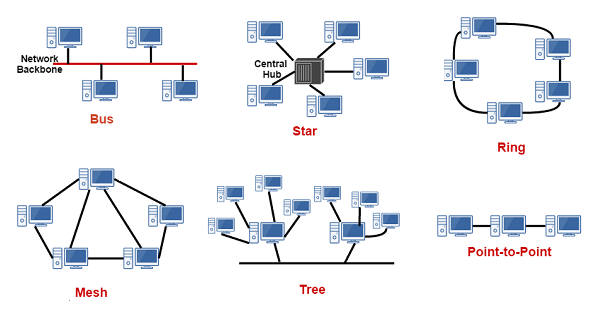What is a Network?
A
network consists of two or more computers that are linked in order to share resources
(such as printers and CDs), exchange files, or allow electronic communications.
The computers on a network may be linked through cables, telephone lines, radio
waves, satellites, or infrared light beams.
Two
very common types of networks include:
- Local Area Network (LAN)
- Metropolitan Area Networks (MAN)
- Wide Area Network (WAN)
You
may also see references to a Metropolitan Area Networks (MAN), a Wireless LAN
(WLAN), or a Wireless WAN (WWAN).
Local Area Network
A
Local Area Network (LAN) is a network that is confined to a relatively small
area. It is generally limited to a geographic area such as a writing lab,
school, or building.
Computers
connected to a network are broadly categorized as servers or workstations.
Servers are generally not used by humans directly, but rather run continuously
to provide "services" to the other computers (and their human users)
on the network. Services provided can include printing and faxing, software
hosting, file storage and sharing, messaging, data storage and retrieval,
complete access control (security) for the network's resources, and many
others.
Workstations
are called such because they typically do have a human user which interacts
with the network through them. Workstations were traditionally considered a
desktop, consisting of a computer, keyboard, display, and mouse, or a laptop,
with with integrated keyboard, display, and touch pad. With the advent of the
tablet computer, and the touch screen devices such as iPad and iPhone, our
definition of workstation is quickly evolving to include those devices, because
of their ability to interact with the network and utilize network services.
Servers
tend to be more powerful than workstations, although configurations are guided
by needs. For example, a group of servers might be located in a secure area,
away from humans, and only accessed through the network. In such cases, it
would be common for the servers to operate without a dedicated display or
keyboard. However, the size and speed of the server's processor(s), hard drive,
and main memory might add dramatically to the cost of the system. On the other
hand, a workstation might not need as much storage or working memory, but might
require an expensive display to accommodate the needs of its user. Every computer
on a network should be appropriately configured for its use.
On
a single LAN, computers and servers may be connected by cables or wirelessly.
Wireless access to a wired network is made possible by wireless access points
(WAPs). These WAP devices provide a bridge between computers and networks. A
typical WAP might have the theoretical capacity to connect hundreds or even
thousands of wireless users to a network, although practical capacity might be
far less.
Nearly
always servers will be connected by cables to the network, because the cable
connections remain the fastest. Workstations which are stationary (desktops)
are also usually connected by a cable to the network, although the cost of
wireless adapters has dropped to the point that, when installing workstations
in an existing facility with inadequate wiring, it can be easier and less
expensive to use wireless for a desktop.
See
the Topology, Cabling, and Hardware sections of this
tutorial for more information on the configuration of a LAN.
Metropolitan Area Network
A
metropolitan area network is a computer network that interconnects users with
computer resources in a geographic area or region larger than that covered by
even a large local area network but smaller than the area covered by a wide
area network.
Wide Area Network
Wide
Area Networks (WANs) connect networks in larger geographic areas, such as
Florida, the United States, or the world. Dedicated transoceanic cabling or
satellite uplinks may be used to connect this type of global network.
Using
a WAN, schools in Florida can communicate with places like Tokyo in a matter of
seconds, without paying enormous phone bills. Two users a half-world apart with
workstations equipped with microphones and a webcams might teleconference in
real time. A WAN is complicated. It uses multiplexers, bridges, and routers to
connect local and metropolitan networks to global communications networks like
the Internet. To users, however, a WAN will not appear to be much different
than a LAN.
Network t0pologies and types of networks
The
term network topology describes the relationship of connected devices in terms
of a geometric graph. Devices are represented as vertices, and their
connections are represented as edges on the graph. It describes how many connections
each device has, in what order, and what sort of hierarchy.
Typical
network configurations include the bus topology, mesh topology, ring topology,
star topology, tree topology and hybrid topology.
Most
home networks are configured in a tree topology that is connected to the
Internet. Corporate networks often use tree t0pologies, but they typically
incorporate star topology and an Intranet.
What was the first computer network?
One of the first computer networks to use packet
switching, ARPANET was developed in the mid-1960s and is considering to be the
direct predecessor of the modern Internet. The first ARPANET message was sent
on October 29, 1969.







0 comments:
Post a Comment